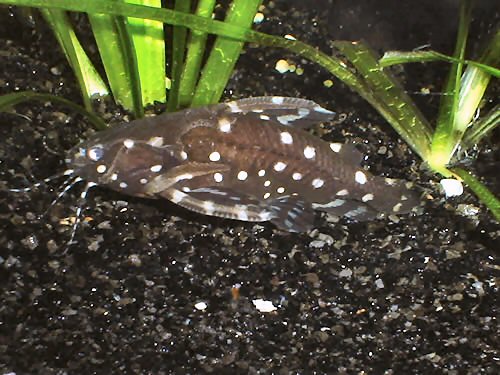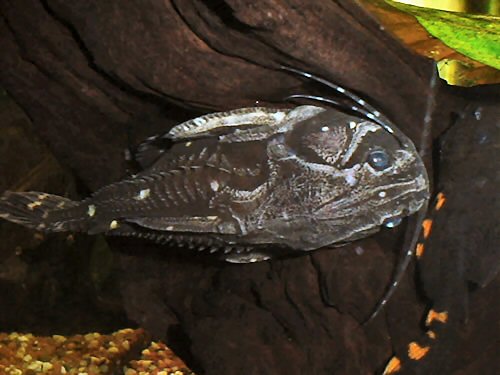Agamyxis pectinifrons (Cope, 1870)
|
| Synonyms: |
| Doras pectinifrons, Doras flavopictus |
| Common Name: |
| Spotted talking catfish |
| Family: |
| Doradidae |
| Subfamily: |
| Doradinae |
| Distribution: |
 Ecuador Ecuador
 Peru Peru |
| Size: |
| 14.0cm. (5½ins) |
| Temp: |
| 20-26°C (67-79°F) |
| pH.: |
| 6.0 - 7.5 |

his month we concentrate on a very weird member of the Doradidae family, namely the "Spotted talking catfish" Agamyxis pectinifrons. This catfish has been in the hobby for many years and is sometimes overlooked in the quest for the more gaudy colours of the members of the Loricariidae family, i.e. the L-numbers, but as you can see in the picture below it can even rival them in the colourful stakes.
There are two species in this genus, the aforementioned A. pectinifrons and A. albomaculatus (Peters, 1877). A. pectinifrons is found in Ecuador and Peru while A. albomaculatus is only found in Venezuela. There is not a great deal of differences as far as I can see in the 2 species apart from maybealbomaculatus being a bit slimmer and having more spots. There also seems to be a different pattern in the caudal fin.
The first thing you notice is the weird shape reminiscent of the "Hunchback of Notre dam" and old specimens can get very hunchbacked in their advancing years. This is a very long lived species with reports of 17 years longevity and are very hardy to boot!.
A basic setup for the "Spotted talking catfish" would be a not too brightly lit aquarium with bogwood or equivalent for them to hide away in the roots or in the crevices of carefully stacked stonework. Substrate is not a great issue with either rounded gravel or sand. A regime of monthly water changes should keep this catfish happy for many years.
It is very nocturnal as are most members of this family and you must be aware of their pectoral spines as they can lock them and if your fingers are in the road it can be mighty painful!. If catching this species for any reason you must not use a net as their spines will get hopelessly entangled. A better method is to lower a container to scoop it up in. If you must handle this fish, make sure that you grasp it forward of the pectoral spines in the head area.
In common with most of the Doradidae family when out of the water, it can create a sound by grating its fin bones in each socket and amplifying the noise via the swim bladder, which is one reason why it commands the common name of the “Spotted Talking Catfish”
D 1/5; A 1/11; P1/5. Dorsal spine toothed on both anterior and posterior surfaces. Spinous scutes confined to the posterior half of the body. 3 pairs of barbels. Caudal shape, truncate.
Dark brown to blue-black, with numerous pale blotches/spots on the head and body. Underside somewhat paler, similarly marked. Fins dark, with pale stripes and spots which may run together to form transverse bars. Old individuals are almost uniformly dark brown with white blotches on the belly.
Good community catfish although very nocturnal. May eat very small fish or fry on night time forages.
No reports on the breeding of this species in captivity but may lay its eggs in floating plants in its natural habitat.
A good practice is to drop tablet food at dusk, in the area where it resides. It will eat a wide variety of foods including flake, and frozen foods such as bloodworm.
| Etymology |
Agamyxis : With (very) much slime.
pectinifrons : With a comb on the forehead, (probably refers to the toothed dorsal fin spine.)
|
| Factsheet Request |
Matthew Childers |
| References |
sterba, Günther; Freshwater Fishes of the World 1.
Jonas Hansel @


![[uNGu]™](https://blogger.googleusercontent.com/img/b/R29vZ2xl/AVvXsEgrPnhQswWH1n3co_BH9h53yVB4bM90uN-8zYlArwsG5kGjTCPGH7df0Y3uZofyDG2x9zRWH_wjTJ8NDmxsO-H3eYm9EXels8TVpJLKCth08DpTMXgxDvj_5BJCNRK0xall6aKLawXkQEER/s1600-r/Ungu_long.JPG)















0 comments:
Posting Komentar